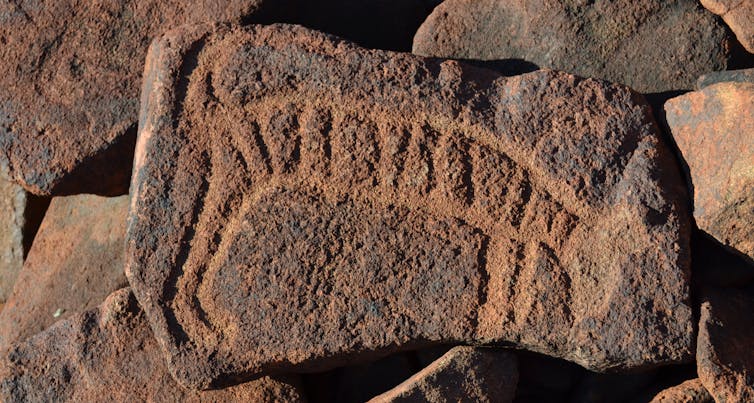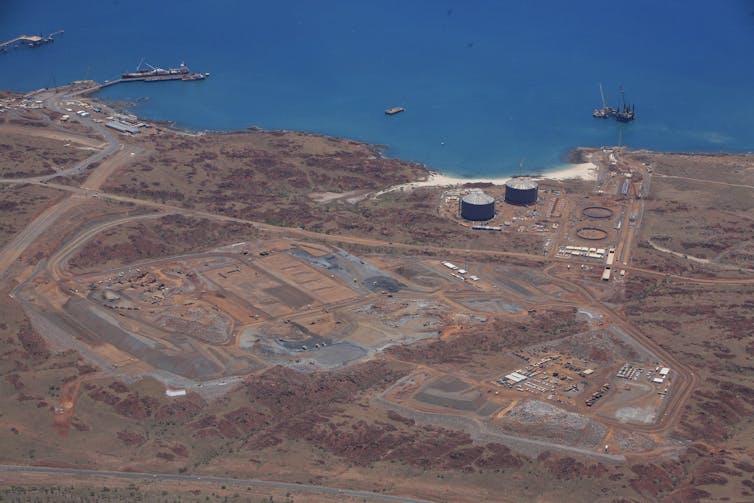Why scientific monitoring of the effects of industry on our priceless WA rock art is inadequate
Scientific studies used to monitor the impact of industry on Aboriginal rock art in north west Western Australia are inadequate, potentially exposing more than a million individual artworks to damage, according to a recent paper published by myself and co-authors in the journal Rock Art Research.
The rock art is located near the towns of Dampier and Karratha and is known as the Burrup Peninsula, or Murujuga. It is a priceless, irreplaceable, cultural and archaeological treasure. The peninsula is also home to industry including an iron ore export port, natural gas processing, liquefying and export facilities, an ammonia-urea fertiliser plant and most recently, an ammonium nitrate production facility for explosives.
The industry and port produce thousands of tonnes of acid-forming emissions each year, permitted under environmental regulations. The impact of these emissions has been monitored through several scientific studies, which claimed there was no consistent impact on the rock art.
However our paper shows that the four main studies cannot be used to monitor the impact of industry on the art due to methodological errors. For example, one study subjected rocks to acid-forming emissions and concluded that there was no consistent change in colour. But there were just not enough repeat measurements to gain any sensible conclusion about the effect of emissions on rock colour.
Another experiment examining the effects of varying acid and other chemical concentrations was conducted using iron ore, which has no relevance to the rocks on which the art is situated. Measurements of colour change between 2004 and 2014 were also made on the rock art and background rock at seven different sites. But the instruments used for measuring change in rock surface colour were designed for indoor use and were inappropriate for the highly variable, hot rock surfaces of Murujuga. Typically, instruments were located at only one place on the rock surface during a measurement each year and this was insufficient to represent the highly variable rock surface.
These studies form the basis for government regulation, which permits industry to release acid-forming emissions. While there is no conclusive evidence that industry emissions have damaged the rock art, recent measurements of the surface of rocks near industry by Dr Ian MacLeod, former Director of the Western Australian Maritime Museum, found acidity to have increased 1,000 times above pre-industrial levels.
We showed in another scientific paper published earlier this year that acid dissolves the outer surface layer of the rocks causing them to become thinner, lighter in colour and to flake away. Once the outer surface layer is removed, the rock art is lost.
The federal government is conducting a senate inquiry into the health of the Murujuga rock art, with a delayed final report due in late November. I argue that, at the very least, industry must install technology to reduce acid emissions and ammonium nitrate dust particles to virtually zero. Other rock art experts have called for a cessation of all industry on the peninsula in a recent editorial in Rock Art Research.
Priceless history
The Murujuga rock art captures over 45,000 years of human culture, activity and spiritual beliefs through ever changing environments from when the sea was more than 100 km from its current position and through the last ice age, 20,000 years ago.
The petroglyphs include some of the oldest known representations of the human face in the world. There are images of extinct mammals including megafauna, the fat-tailed kangaroo and thylacine. There are elaborate geometric designs that could have been used for navigation or an early form of mathematics. There are many depictions of hunting and cultural ceremonies as well as existing animals, birds and sea creatures.

The Murujuga inhabitants created this rock art until February 1868, when virtually the entire Yaburara indigenous population was exterminated in a massacre.
Massacre of the Yaburara, only three years after European settlement in 1865, has deprived us from knowing the storylines and cultural meaning of the petroglyphs. Equally significantly, the massacre broke continuous inhabitation of the area, which has allowed successive Western Australian governments to develop in the midst of the rock art one of the largest industrial complexes in the Southern Hemisphere.
Industry and art
Construction of the industries is estimated by archaeologists working on Murujuga to have resulted in the destruction of over 30,000 petroglyphs through removal and physical damage. Atmospheric emissions from the industries are immense.
Dampier port, which is adjacent to the petroglyphs, is one of the busiest bulk-ports in the world with over 19,000 ship movements each year. These ships burn high sulphur bunker fuel, with one ship emitting as much as 5,000 tonnes of sulphur dioxide per year.
The gas and fertiliser plants emit around 34,000 tonnes of acid forming compounds into the air each year. The recent starting up of the ammonium nitrate plant revealed a huge yellow-orange cloud of nitrogen dioxide with concentrations of over 1,000 parts per million. The emission of nitrogen dioxide from the plant will occur around six times each year, whenever certain industrial chemicals needed for ammonium nitrate production require replacing.
These emissions are permitted under state and federal environmental regulation. Both nitrogen and sulphur dioxide react with water to form acids which are deposited on the rock surfaces.

Extraordinary origins
The rock art at Murujuga is threatened by acid because of its unique geological properties. The natural blue-grey rock, formed from cooling magma, weathers very slowly to form a yellow coloured weathering rind, which may grow by 5 mm in 30,000 years.
The yellow coloured rind is covered with a dark brown-black coating called a patina or rock varnish. The petroglyphs were formed by using hard pieces of rock to break through the patina and expose the rind.
This patina is an extraordinary substance. It is formed by specialised bacteria and fungi on the rock surface, where there is seldom moisture and rock temperatures can exceed 70℃. To survive the harsh conditions, the organisms build a mineral sheath. When they die, their body and sheath combine with clay from the dust to form the hard, dark-coloured patina.
Destruction of the outer patina results in disappearance of the rock art. There is evidence that the patina is flaking on some rocks with petroglyphs. The patina becomes thin and flakes away under acidic conditions.
Protecting the art
Elsewhere in the world countries have been vigilant in protecting natural and cultural heritage from acid emissions. In the US cars are banned or severely limited in many national parks because the acid formed from nitrogen dioxide, produced from vehicle exhaust, will damage the forests.
In France, the 1.4 million annual visitors to the 17,000-year-old Lascaux cave paintings do not see the actual paintings, but a replica in an adjoining cave because of the damage caused by emissions from human breath.
Similarly, the UK government announced in January this year they are building a £1.4 billion tunnel to remove cars form the vicinity of their 4,500-year-old heritage in Stonehenge.
While removing industry may be the best solution to ensure the rock art’s safety, it may not be practical. Governments and industry must recognise their social responsibilities and ensure sufficient technology is in place to reduce acid forming emissions to near zero.
https://theconversation.com/why-scientific-monitoring-of-the-effects-of-industry-on-our-priceless-wa-rock-art-is-inadequate-86317

0 Comments:
Post a Comment
Subscribe to Post Comments [Atom]
<< Home